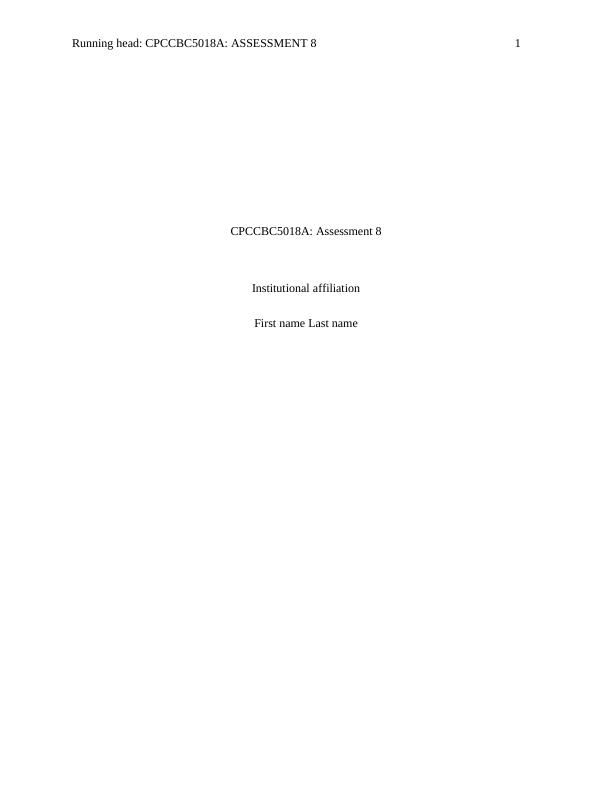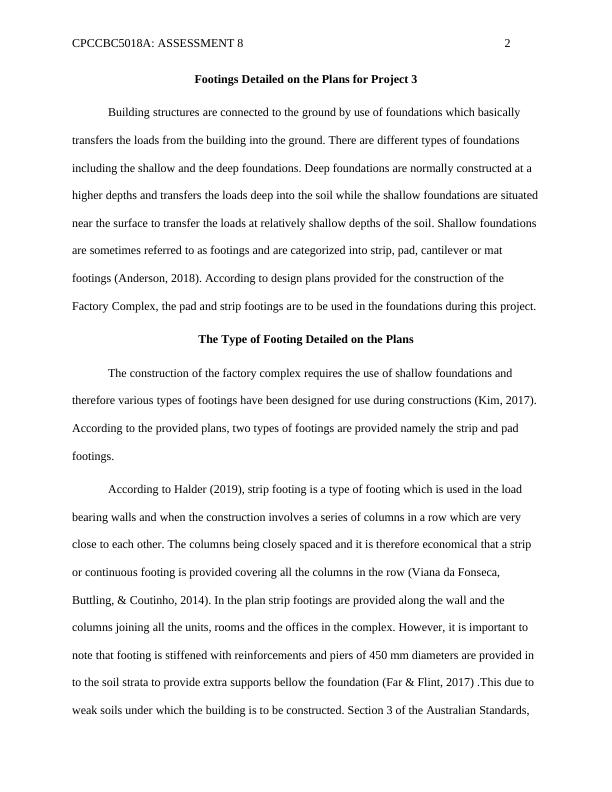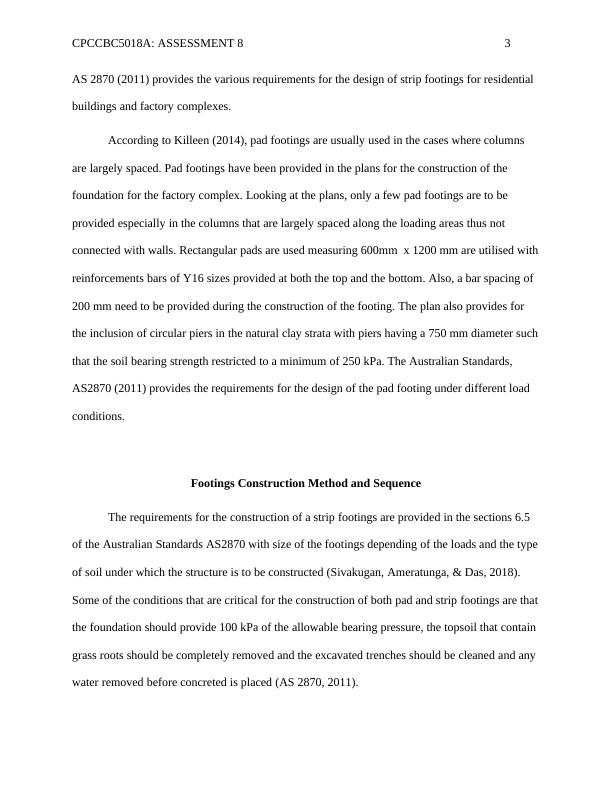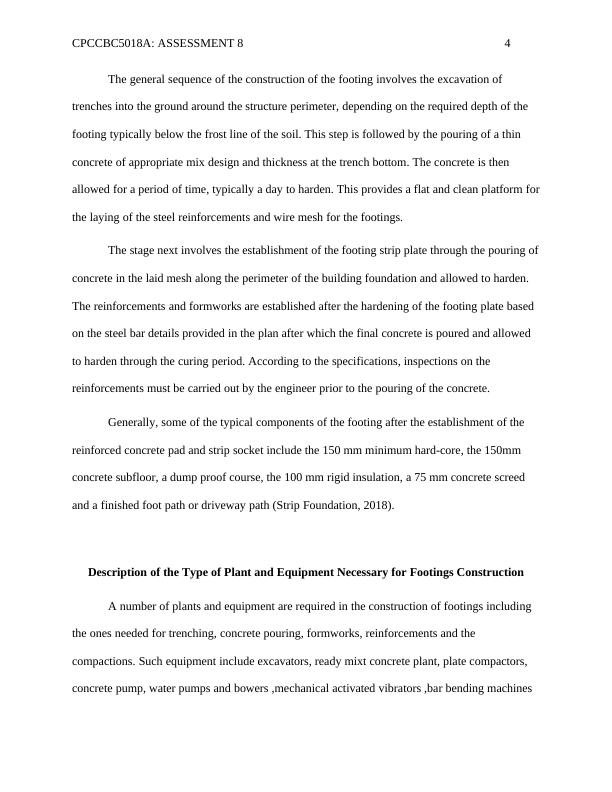Institutional Affiliation Assessment 2022
Added on 2022-10-11
15 Pages3066 Words14 Views
Running head: CPCCBC5018A: ASSESSMENT 8 1
CPCCBC5018A: Assessment 8
Institutional affiliation
First name Last name
CPCCBC5018A: Assessment 8
Institutional affiliation
First name Last name

CPCCBC5018A: ASSESSMENT 8 2
Footings Detailed on the Plans for Project 3
Building structures are connected to the ground by use of foundations which basically
transfers the loads from the building into the ground. There are different types of foundations
including the shallow and the deep foundations. Deep foundations are normally constructed at a
higher depths and transfers the loads deep into the soil while the shallow foundations are situated
near the surface to transfer the loads at relatively shallow depths of the soil. Shallow foundations
are sometimes referred to as footings and are categorized into strip, pad, cantilever or mat
footings (Anderson, 2018). According to design plans provided for the construction of the
Factory Complex, the pad and strip footings are to be used in the foundations during this project.
The Type of Footing Detailed on the Plans
The construction of the factory complex requires the use of shallow foundations and
therefore various types of footings have been designed for use during constructions (Kim, 2017).
According to the provided plans, two types of footings are provided namely the strip and pad
footings.
According to Halder (2019), strip footing is a type of footing which is used in the load
bearing walls and when the construction involves a series of columns in a row which are very
close to each other. The columns being closely spaced and it is therefore economical that a strip
or continuous footing is provided covering all the columns in the row (Viana da Fonseca,
Buttling, & Coutinho, 2014). In the plan strip footings are provided along the wall and the
columns joining all the units, rooms and the offices in the complex. However, it is important to
note that footing is stiffened with reinforcements and piers of 450 mm diameters are provided in
to the soil strata to provide extra supports bellow the foundation (Far & Flint, 2017) .This due to
weak soils under which the building is to be constructed. Section 3 of the Australian Standards,
Footings Detailed on the Plans for Project 3
Building structures are connected to the ground by use of foundations which basically
transfers the loads from the building into the ground. There are different types of foundations
including the shallow and the deep foundations. Deep foundations are normally constructed at a
higher depths and transfers the loads deep into the soil while the shallow foundations are situated
near the surface to transfer the loads at relatively shallow depths of the soil. Shallow foundations
are sometimes referred to as footings and are categorized into strip, pad, cantilever or mat
footings (Anderson, 2018). According to design plans provided for the construction of the
Factory Complex, the pad and strip footings are to be used in the foundations during this project.
The Type of Footing Detailed on the Plans
The construction of the factory complex requires the use of shallow foundations and
therefore various types of footings have been designed for use during constructions (Kim, 2017).
According to the provided plans, two types of footings are provided namely the strip and pad
footings.
According to Halder (2019), strip footing is a type of footing which is used in the load
bearing walls and when the construction involves a series of columns in a row which are very
close to each other. The columns being closely spaced and it is therefore economical that a strip
or continuous footing is provided covering all the columns in the row (Viana da Fonseca,
Buttling, & Coutinho, 2014). In the plan strip footings are provided along the wall and the
columns joining all the units, rooms and the offices in the complex. However, it is important to
note that footing is stiffened with reinforcements and piers of 450 mm diameters are provided in
to the soil strata to provide extra supports bellow the foundation (Far & Flint, 2017) .This due to
weak soils under which the building is to be constructed. Section 3 of the Australian Standards,

CPCCBC5018A: ASSESSMENT 8 3
AS 2870 (2011) provides the various requirements for the design of strip footings for residential
buildings and factory complexes.
According to Killeen (2014), pad footings are usually used in the cases where columns
are largely spaced. Pad footings have been provided in the plans for the construction of the
foundation for the factory complex. Looking at the plans, only a few pad footings are to be
provided especially in the columns that are largely spaced along the loading areas thus not
connected with walls. Rectangular pads are used measuring 600mm x 1200 mm are utilised with
reinforcements bars of Y16 sizes provided at both the top and the bottom. Also, a bar spacing of
200 mm need to be provided during the construction of the footing. The plan also provides for
the inclusion of circular piers in the natural clay strata with piers having a 750 mm diameter such
that the soil bearing strength restricted to a minimum of 250 kPa. The Australian Standards,
AS2870 (2011) provides the requirements for the design of the pad footing under different load
conditions.
Footings Construction Method and Sequence
The requirements for the construction of a strip footings are provided in the sections 6.5
of the Australian Standards AS2870 with size of the footings depending of the loads and the type
of soil under which the structure is to be constructed (Sivakugan, Ameratunga, & Das, 2018).
Some of the conditions that are critical for the construction of both pad and strip footings are that
the foundation should provide 100 kPa of the allowable bearing pressure, the topsoil that contain
grass roots should be completely removed and the excavated trenches should be cleaned and any
water removed before concreted is placed (AS 2870, 2011).
AS 2870 (2011) provides the various requirements for the design of strip footings for residential
buildings and factory complexes.
According to Killeen (2014), pad footings are usually used in the cases where columns
are largely spaced. Pad footings have been provided in the plans for the construction of the
foundation for the factory complex. Looking at the plans, only a few pad footings are to be
provided especially in the columns that are largely spaced along the loading areas thus not
connected with walls. Rectangular pads are used measuring 600mm x 1200 mm are utilised with
reinforcements bars of Y16 sizes provided at both the top and the bottom. Also, a bar spacing of
200 mm need to be provided during the construction of the footing. The plan also provides for
the inclusion of circular piers in the natural clay strata with piers having a 750 mm diameter such
that the soil bearing strength restricted to a minimum of 250 kPa. The Australian Standards,
AS2870 (2011) provides the requirements for the design of the pad footing under different load
conditions.
Footings Construction Method and Sequence
The requirements for the construction of a strip footings are provided in the sections 6.5
of the Australian Standards AS2870 with size of the footings depending of the loads and the type
of soil under which the structure is to be constructed (Sivakugan, Ameratunga, & Das, 2018).
Some of the conditions that are critical for the construction of both pad and strip footings are that
the foundation should provide 100 kPa of the allowable bearing pressure, the topsoil that contain
grass roots should be completely removed and the excavated trenches should be cleaned and any
water removed before concreted is placed (AS 2870, 2011).

CPCCBC5018A: ASSESSMENT 8 4
The general sequence of the construction of the footing involves the excavation of
trenches into the ground around the structure perimeter, depending on the required depth of the
footing typically below the frost line of the soil. This step is followed by the pouring of a thin
concrete of appropriate mix design and thickness at the trench bottom. The concrete is then
allowed for a period of time, typically a day to harden. This provides a flat and clean platform for
the laying of the steel reinforcements and wire mesh for the footings.
The stage next involves the establishment of the footing strip plate through the pouring of
concrete in the laid mesh along the perimeter of the building foundation and allowed to harden.
The reinforcements and formworks are established after the hardening of the footing plate based
on the steel bar details provided in the plan after which the final concrete is poured and allowed
to harden through the curing period. According to the specifications, inspections on the
reinforcements must be carried out by the engineer prior to the pouring of the concrete.
Generally, some of the typical components of the footing after the establishment of the
reinforced concrete pad and strip socket include the 150 mm minimum hard-core, the 150mm
concrete subfloor, a dump proof course, the 100 mm rigid insulation, a 75 mm concrete screed
and a finished foot path or driveway path (Strip Foundation, 2018).
Description of the Type of Plant and Equipment Necessary for Footings Construction
A number of plants and equipment are required in the construction of footings including
the ones needed for trenching, concrete pouring, formworks, reinforcements and the
compactions. Such equipment include excavators, ready mixt concrete plant, plate compactors,
concrete pump, water pumps and bowers ,mechanical activated vibrators ,bar bending machines
The general sequence of the construction of the footing involves the excavation of
trenches into the ground around the structure perimeter, depending on the required depth of the
footing typically below the frost line of the soil. This step is followed by the pouring of a thin
concrete of appropriate mix design and thickness at the trench bottom. The concrete is then
allowed for a period of time, typically a day to harden. This provides a flat and clean platform for
the laying of the steel reinforcements and wire mesh for the footings.
The stage next involves the establishment of the footing strip plate through the pouring of
concrete in the laid mesh along the perimeter of the building foundation and allowed to harden.
The reinforcements and formworks are established after the hardening of the footing plate based
on the steel bar details provided in the plan after which the final concrete is poured and allowed
to harden through the curing period. According to the specifications, inspections on the
reinforcements must be carried out by the engineer prior to the pouring of the concrete.
Generally, some of the typical components of the footing after the establishment of the
reinforced concrete pad and strip socket include the 150 mm minimum hard-core, the 150mm
concrete subfloor, a dump proof course, the 100 mm rigid insulation, a 75 mm concrete screed
and a finished foot path or driveway path (Strip Foundation, 2018).
Description of the Type of Plant and Equipment Necessary for Footings Construction
A number of plants and equipment are required in the construction of footings including
the ones needed for trenching, concrete pouring, formworks, reinforcements and the
compactions. Such equipment include excavators, ready mixt concrete plant, plate compactors,
concrete pump, water pumps and bowers ,mechanical activated vibrators ,bar bending machines

End of preview
Want to access all the pages? Upload your documents or become a member.
Related Documents
Building and Construction Assignment: Footings, Construction Methods, Equipment, Wall Panel Support, and Termite Protectionlg...
|11
|2259
|328
Combined pad Foundation Assessment 2023lg...
|20
|2074
|15
Applying Structural Principles to Construct Medium Size Buildinglg...
|13
|3394
|243
Sittingbourne Footing System Assignmentlg...
|27
|1880
|48
CPCCBC4011B: Assessment 4 - Footing, Retaining Wall, Structural, Floor, Wall, Roof, Services, Fire Prevention, Qualitylg...
|9
|843
|328
Building Systems and Structural Connections for a Middle Rise Buildinglg...
|11
|1147
|450